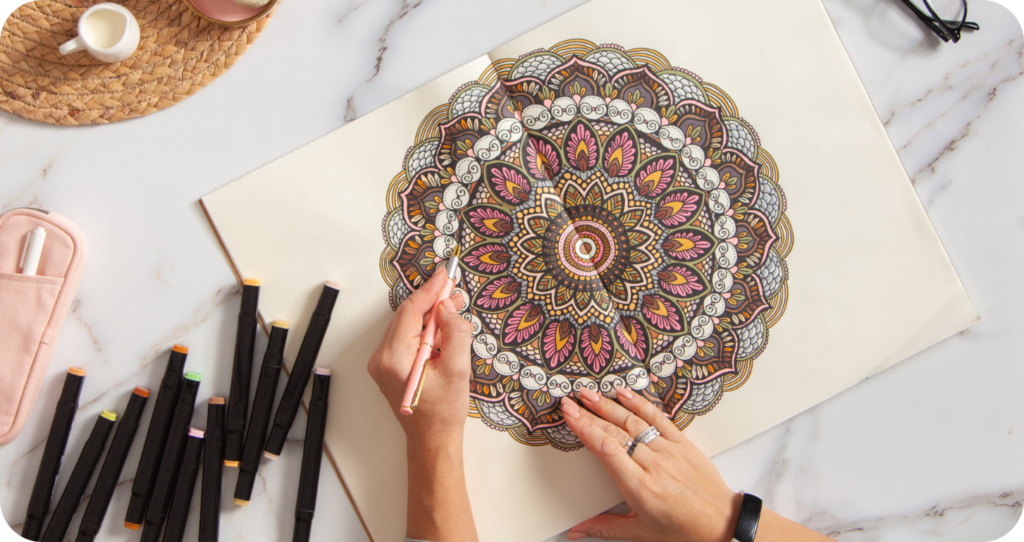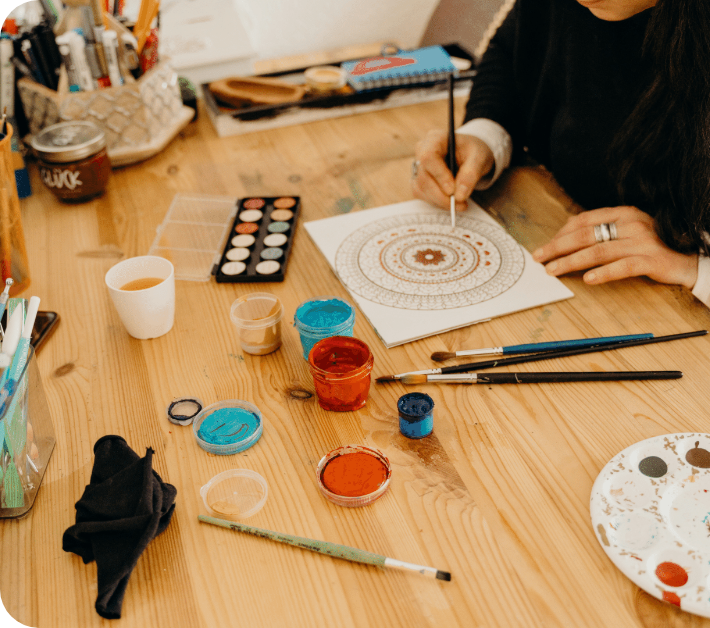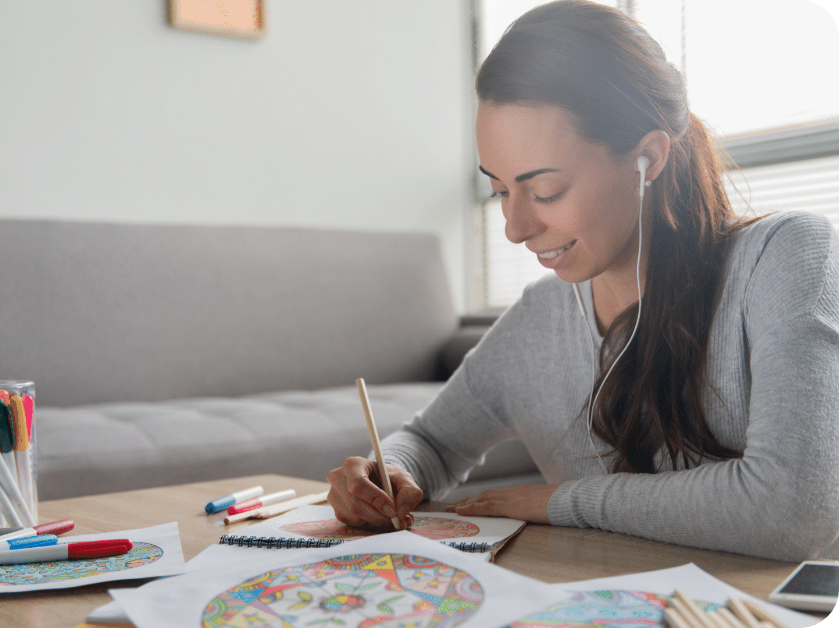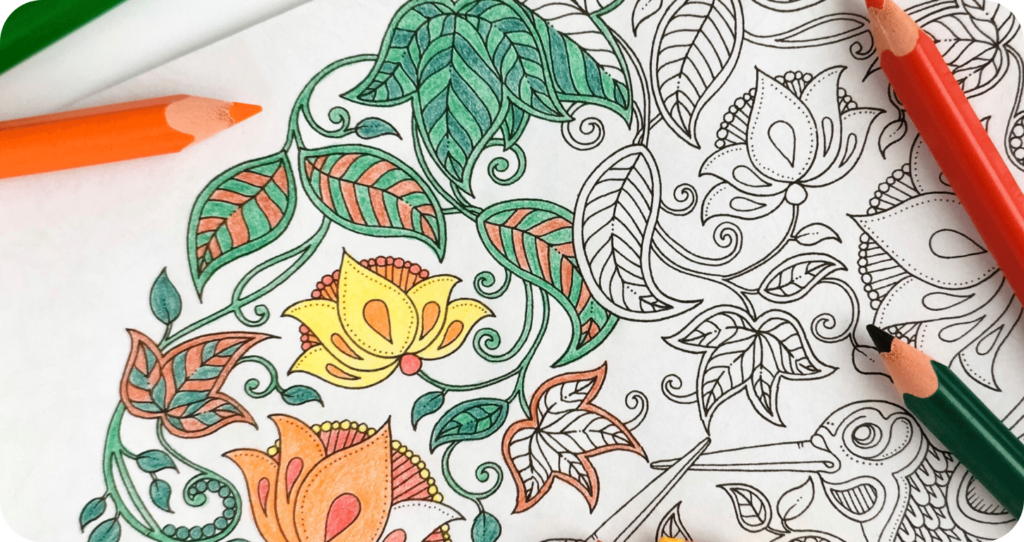Art That Can Heal You And Elevate Your Well-Being: Mandala Art
Pavani Mantripragada
January 2 2023. 5 minute Read
The word mandala is a Sanskrit word from the manda meaning essence, and the suffix la refers to the possessor. The word mandala means one that possesses the soul.
In traditional practice, we can always use mandalas in many ways. You can even draw a rangoli and invoke a deity with a specific pattern. Geometry has profoundly influenced Hinduism, Tibetan Buddhism, and Jainism. All of these make use of mandalas for various purposes.
But What Exactly is A Mandala ?
A mandala is a geometric pattern that repeats itself within the design. Mandala is a geometric art that is symmetrical.
Geometry and Mandala
While most art mandalas have circular designs, they can also have a star or square designs. You can even use the concentric circle in the design itself. Every shape, whether circle, Star, square, or triangle, had its meaning. Even the colors in the Mandala have sense.
Mandala art is all about geometry. Here every shape and structure has a different meaning.
- The Star represents spirituality and freedom.
- The circle represents completeness, unity, and integrity.
- Square represents stability and balance.
- The upward triangle represents the soul's movement toward the divine, and
- The downward triangle represents Prakriti.

Significance of Colors in Mandala
In Mandala art, if you see what I have understood, they use a lot of Primary colors such as Red, Blue, and Green. Here, different have different significance.
- Here, Green represents nature and abundance.
- White represents tranquility and serenity.
- Red represents fire and passion.
- Yellow represents power and joy.
Traditional Tantra uses these mandalas to enrich their meditative experience and to invoke the deity. You can also use Mandala art for spiritual healing.
But Are Mandalas Restricted Just To Spiritual Fold?
Dr. Carl Jung, the founder of Analytical Psychology, a Swiss Psychologist and Psychoanalyst, introduced the mandala art within therapy. He said, “I sketched a small circular drawing every morning in a notebook, which seemed to correspond to my inner situation at the time. Only gradually did I discover what the Mandala is: the Self, the wholeness of the personality, which, if all goes well, is harmonious.”
Research has shown that Mandala Drawing has a significant effect on subjective well-being. The study had 79 students selected and divided into two groups. One group was Individual Mandala Drawing (IMD), and the other was Cooperative Mandala Drawing (CMD). It showed that IMD and CMD significantly helped develop spirituality and happiness. CMD had comparatively greater levels of Subject Well Being than those in IMD.
Benefits of Mandala Art:
- Mandala art can help reduce anxiety in people with physical, mental, and intellectual disabilities.
- Mandala drawing art therapy helps recognize psychiatric illnesses in the typical crowd.
- It also helps to reduce depression and anxiety among women and students.
- Mandala Art Therapy can also help increase mindfulness in youngsters,.
- Mandala Art Therapy can also help in spiritual and mental well-being among nurses, and
- Mandala Art Therapy can even positively affect general subjective well-being.
Art Therapy is a typical therapy to reduce anxiety and depression, which has a more significant effect in reducing these problems.


The Art of Symmetry makes the Mandala so Effective
It is a common practice to use mandalas within Tantra to enhance their experience. Not just Tantra, even Yoga uses mandalas to improve the energy experience.
There is a specific psychological aspect with a repetitive pattern and Symmetry. One tends to look at the symmetrical design longer than the asymmetrical one. Across the boundaries of species, geography, cultures, and age, the balance has a particular advantage over the others.
Note: Symmetrical objects can bring pleasure to the brain.
Nature has provided the world with the wiring of having the aesthetic pleasure of viewing symmetrical design. More often than not, an asymmetry can point to danger or illness in nature.
Just look at a flower. Each of its petals is of the same size. The number of petals may differ from flower to flower, and it bothers me when you don’t find one petal greater in size than the other. You would pay much attention to a flower that had different sizes of petals in the same flower: Roses, Tulips, Chrysanthemums, and many such flowers.
Or at the wings of a butterfly. Symmetry is quite essential.
One wing cannot be greater than the other. Each wing would have a similar design. Or even at yourself. For example, the size of our arms is the same. The size of your legs is the same. Both your feet are of the same size. We all know that if it is not the same size, we need to see the doctor.
We all prefer Symmetry. Our brain reacts well to anything of symmetrical pattern and has evolved parallelly to that of star fishes and octopuses. Hence, the basal wiring remains the same.
Repetitive patterns create an effect on the brain. A lot of designers use repetitive patterns in designs to allure the viewer. It can have a hypnotic effect on the brain. In Hypnosis, they show a pattern that repeats and continues with no dead end. Hence, our brain gets wired to have that soothing effect when we look at Symmetry.
A mandala is similar. The pattern is repetitive, continuous, and symmetrical.

Repetitive patterns create an effect on the brain. A lot of designers use repetitive patterns in designs to allure the viewer. It can have a hypnotic effect on the brain. In Hypnosis, they show a pattern that repeats and continues with no dead end. Hence, our brain gets wired to have that soothing effect when we look at Symmetry.
A mandala is similar. The pattern is repetitive, continuous, and symmetrical.
Spirituality and Mandalas
Spiritual healing is a way of self-healing the mind. Our mind goes through a lot of stress and problems the whole time. In such a case, healing becomes greatly necessary. Mandalas are very efficient in healing. It is used extensively in spiritual healing in Hinduism, Tibetian Buddhism, Native American, and Aboriginal Australian cultures.
Tantra has elaborate mandalas called yantras. Several yantras have various purposes: some to attract wealth, some for peace, and many others. Similarly, we can use some yantras for healing, like Dhanvantari Yantra.
Another one used widely for yantra is Mahamritunjaya Yantra.
Both these yantras are used within Hinduism to heal.
Buddism uses Sand mandalas as a part of their spiritual healing. They are infamous for creating such an elaborate mandala and then destroying it the next moment. I want to ask why. “Nothing in this world is permanent. One must not form an attachment to anything. This is to teach you not to attach yourself to anything,” They say.
Native Americans have the Medicine Wheel, which they believe can heal people from various illnesses. They also use dream catchers to drive away bad dreams.
Mandalas are known for their effect on meditation. Many Tibetan Buddhist temples contain mandalas on the ceilings to create the effect.
Many Hindu temples have a specific mandala style. The pillars are in proper places, have repetitive designs, and have primarily geometric shapes. They can help elevate your spiritual experience and bring you into a state where you can stop all your thoughts and stay without any worries, opinions, or imaginations.

Final Thoughts
Mandalas Art Therapy has grown dramatically over the years. It benefits Spiritual Well-being, Mental well-being, Stress reduction, Anxiety Therapy, Blood Pressure, and Relaxation activity. A friend who draws Mandala art often says, “It has something about it which will make you relaxed. When you first start with mandala art therapy, you will stress largely on the design and Symmetry, but soon you will grow into it. The hands which shook out of worry of messing it up now are quite steady. That’s how you learn to reduce stress.”
Subscribe to our new post
The One Liner
Useful Links
Order Related Queries
Useful Links
Order Related Queries


